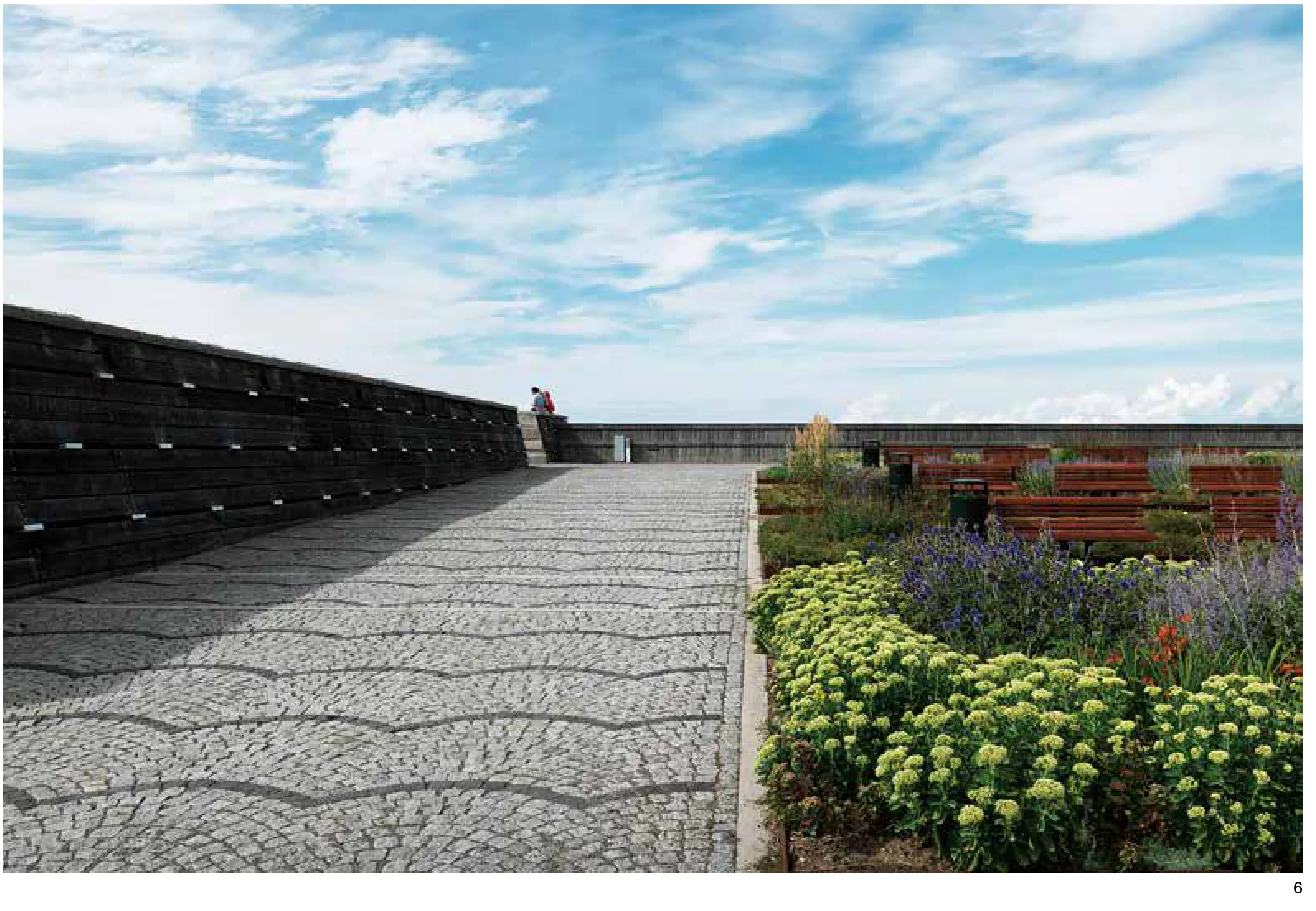瑞典马尔默市达尼亚公园
2016-05-12图尔比约恩·安德森,PeGeHillinge,满园
瑞典马尔默市达尼亚公园
The Dania Park, Malmö, Sweden.

1达尼亚公园平面图(斯维克建筑事务所提供 )Site plan of the Dania Park. Image by Sweco Architects
达尼亚公园是过去20年,第一批建设在瑞典密集型社区内的实质性城市公园。同时,它也是自20世纪50年代所谓的斯德哥尔摩公园设计学院时期以来,所建设的最大城市公园之一。
除了设计的常规流程,达尼亚公园还要面临两个重要问题:其一环境方面,基址的土壤带有毒性;其二社会方面,该公园是重要的公共活动空间。为了应对环境问题,设计师将被污染的淤泥以黏土密封,经过许可,同时被密封的还有排水系统。取而代之的是利用地表细沟和渗透床来对雨水径流进行管理。至于社会问题,公园在如何丰富游客活动和游览体验方面下了很大功夫。
像许多欧洲城市一样,马尔默——虽然是一个海港城市,却一直与大海没有关联。西部港口区域的城市发展现在加强了马尔默与水之间的联系。而作为西部港口的主要城市空间,达尼亚公园利用它极佳的地理位置将新建居住区和大海的自然之力连接了起来。
达尼亚公园的设计获益于其介于城市和自然之间的兼容性。它拥有广阔开放的海滨风景,也是被公众强烈需求的社会空间。在夏日里,公园里到处是游戏的人们——他们晒太阳、游泳、野餐,享受闲暇时光。而在冬季,总有人独自前来,在户外感受着咆哮的大海以及猛烈的海风。

2“延伸跳板”吸引了很多人( 斯坎皮克斯提供 )The prow attracts crowds. Photo by Scanpix
达尼亚公园坐落在分隔丹麦与瑞典的厄勒海峡海岸线上。原场地是垃圾填埋的产物,完全是平整的——实际上就是一片充斥着脏污不堪的淤泥的工业荒漠。场地荒凉的现状条件使人难以认知,最终那些自然中瞬息万变的元素反而构成了设计的主角:光、海平面、一望无际的远景、天空、风以及大海。
这些特质为公园的设计提供了灵感点,同时也回应了自然主义景观的理念。尺度巨大的海岸景观以一览无遗的处理方式体现到公园的设计当中。这种开放性也是意图与马尔默市稠密、不规则、空间细碎的城市结构形成对比 。

3 这个像船头一样的装置为爱冒险的人们提供了跳水的地方(伦纳特·彼得森提供)The prow supplies with adventurous diving for the daring. Photo by Lennart Pettersson

4 公园面向瑞典与丹麦之间的海峡(莉娜·阿松提供 )The park faces the strait between Sweden and Denmark. Photo by Lena Ason
公园的面积约有两个足球场大小,但它在结构上与开放的中心草坪不同,采用了很多相对较小的限定型空间设计。茂密的植被保护带保护了草坪区域免受海上强风的侵袭。同时,设计者也精心布置了可以观赏壮观的海峡日落的观景点。
公园最重要的组成要素是瞭望台:3个倾斜的混凝土台,嵌入到岩石堆的海岸线中,让游人们能够深入大海中。这些被称为“堡垒”的平台,架设在海平面上约7m左右的位置,无论是强烈的海风还是壮美的落日,只要站在这里都能够畅快地体验一番。此外,3个木箱组成的“阳台” 提供了俯瞰广阔草坪的场所。草场都被设置在地面以下以便减少强风对其的伤害。同时两排高低错落的树木和低矮的耐盐灌木将强烈的海风隔绝在外。
公园的设计在很大程度上,致力于服务社会活动。公园针对不同使用功能,像是一个俄罗斯套娃一般从大到小一环一环嵌套着,拥有各种尺度和特质的空间。小至只能容纳10-15人活动的露台,大至可以供上千人活动的多功能草坪,应有尽有。
达尼亚公园作为主要的城市公共空间,为旧城的延伸提供了重要的集散中心。西部港口新建区包括600套住房、商店、学校、咖啡馆和办公室。同时,公园在2001年的Bo01国际房地产博览会上扮演了重要角色。在博览会闭幕后的两年中,达尼亚公园已经成为这个城市最受欢迎的旅游景点之一。在这里,婚礼、拍摄时尚大片、家庭野餐的场景随处可见,勇敢的年轻人们不顾“禁止跳水”的标志纵身跃入大海。
达尼亚公园位于马尔默,瑞典第三大城市。这座坐落在瑞典南端的城市吸引了众多来自丹麦和瑞典南部的游客。公园的设计方案在1999年的设计竞赛中脱颖而出,并于2002年竣工。

5 公园里的家具拥有一种粗糙纯朴的质感(延斯·林德提供)Park furniture is designed to have a rustic quality. Photo by Jens Lindhe
1 瞭望台
3个倾斜的,向着大海打开的混凝土槽嵌入到高低不平的砾石海岸线中。迎风面有一处防风墙,墙后方是一处被坚实的花岗岩墙包围着的停坐空间,在这里可以舒服地观赏景色。瞭望台中有两个是需要走台阶上去的,另一个则是可以通过短斜坡抵达。这些瞭望台大约可以容纳50人。
2 露台区
3个露天的落叶松木箱,每一个都配备有由柚木制的“沙发”和一颗山楂树。露台的地面被卵石覆盖。焦油不仅被用来给卵石染黑着色,还具备一种海船的特有味道。露台被推入短坡并且可以俯瞰草坪。其中的两个略有抬升,需要走一步台阶;另一个则是平趟在地面上,方便轮椅进入。每个露台大约可以容纳15人。

6 由于坐落在海边,广阔的天空是公园的一大特色。(帕特里克·林德尔提供)Located by the sea, the wide sky is an important feature. Photo by Patrik Lindell
3 堡垒
堡垒是设想在公园的外侧,设置一些巨大的抬升平台,可以成为公园的地标。人们可以在堡垒之上远眺壮观的大海、夕阳,天气好的时候还可以看到丹麦的海岸。围墙圈定了40m见方的范围,可以作为舞台或者公众集会的地方。堡垒装饰着焦油处理过的暗黑色粗糙木板,木板中央放置一块可以让阳光透进来的方形不锈钢构件。虽然市政并不允许,但是这个外表面实在让年轻人忍不住想去攀爬。堡垒区域可以容纳大约300人。
4 延伸跳板
这是一个从堡垒上伸出的像跳板一样的特色装置 。站在上面的时候,你会感觉自己身处于一个海洋与天空之间的自由空间。虽非设计师本意,这里总是会吸引许多勇敢的年轻人前来跳水,这个冒险设施吸引了整个地区的孩子们。
5 防风带
在操场的边缘种植有两排耐盐抗风树木——宽叶花楸(Sorbus latifolia),同时还栽植了包含沙棘(Hippophae rhamnoides)和玫瑰(Rosa rugosa)的绿篱,以起到加强的作用。防风带还将眺望台后部的砾石骑马道与相邻区域分开,引导人们前往未来的住宅区。

7 人们聚集在堡垒的顶部观赏日落(林内亚·斯文松·阿巴卜提供)People gathering to celebrate the sunset on top of the bastion. Photo by Linnea SvenssonArbab
6 草坪
这块被成行树木和露台包围着的开放草坪,是这个新城发展中唯一的大型公共空间。这里可以举办各种各样的娱乐活动,有时甚至会有大型户外音乐会和社区节日。这个区域可以容纳约5 000人。
7 多年生植物阶地
一系列向着草坪逐渐下降的阶地。阶地为人们提供静思空间。成排的木质“沙发”设置在种类多样的多年生植物丛中,这些植物的色彩和长势标志着季节的变化。这片区域约可以容纳100人。
8 家具设施
公园中设置了4种不同的长椅,这些长椅为了匹配公园的横向长度,被设计为6-8m长。它们的木质表面十分坚实,既可以踩在上面,也可以用作野餐桌、观景平台、运动设施——当然也是可以坐的。其所使用的材料是木材、花岗岩和镀锌钢。
9 照明
公园的照明被设计者高度重视。设计目标是在照明的同时让人们不会时时刻刻看到光源所在,露台、堡垒和瞭望台都是通过这种方式布置灯光。设计理念是创造一种有节奏的,能够强调公园内重要特征的灯光系统,同时为游人创造天黑以后依然有趣的游览体验。“隐藏的灯光”是园内灯光系统的主流,除此之外,还有3个巨大的桅杆,桅杆高16m,每1个都配备有6个探照灯泡。
位置:瑞典马尔默
面积:20 000m2
委托方:马尔默市政府
设计师:图尔比约恩·安德森、PeGe Hillinge,SWECO建筑事务所
项目组成员:薇罗妮卡·博格、彼得·诶瑞克、克洛特·弗兰克、斯文·海德伦德、肯尼斯·希尔顿、安德斯·李德森
灯光:迈克尔·哈勃特
落成时间:2002年
成本:450万欧元
施工方:斯堪雅建筑集团及其他分包商
翻译:满园
校对:张诗阳

8 多年生植物种在通往堡垒的大斜坡的背风处(林内亚·斯文松·阿巴卜提供)Perennial plantings in shelter of the big ramp leading to the bastion. Photo by Linnea Svensson Arbab

9 栅栏将公园和大海隔离开来(帕特里克·林德尔提供)The palisade divides the park from the sea. Photo by Patrik Lindell
The Dania Park is one of the fi rst substantial urban park to be built in a dense city neighborhood in Sweden during the last twenty years. And it is also one of the largest city parks to be constructed since the epoch of the so-called Stockholm School of park design in the 1950s.
Apart from the programmatic aspects of its design, the Dania Park addresses two important issues: the primary environmental concern was the toxicity of the soil; socially, the park is an important public space. For the environmental problem, the contaminated mud was sealed with clay with no penetrations, including sewer systems, permitted. Instead, surface rills and infiltration beds manage the in fl ux of storm water. In terms of social issues, the park is completely devoted to visitor activity and experience.

10 在露台上可以俯瞰大草坪(阿克·埃尔森·林德曼提供)The balconies overlooking the great lawn. Photo by Ake Elson Lindman
Like many European cities, Malmö-although a harbor town-has lost its contact with the sea over the years. The urban development of the West Harbor is an effort to strengthen Malmö's connection to the water. As the West Harbor's main civic urban space Dania Park uses its spectacular position to link the new housing with the natural powers of the sea.
The Dania Park has been designed to benefit from this duality of city and nature. It thus has the expanse and openness of the seashore landscape, yet it contains a range of condensed social spaces of a kind required by intense public use. On a summer's day, the park is fi lled with people playing, basking in the sun, swimming, picnicking, and enjoying their leisure time. During the winter months one is often alone out here, with a powerful feeling of an existence among the natural elements: the roaring sea and the strong breeze.
The Dania Park is located on the shoreline of the Öresund sound, the body of water that divides Sweden and Denmark. The product of landfill, the site is totally flat-an industrial desert of contaminated mud. Existing qualities from this desolate site were hard to identify but eventually aspects of a more ephemeral kind emerged as worthy of the designers' consideration: the quality of the light, the horizon, the long views, the sky, the wind, and the sea.
These qualities provided the points of departure for the design of the park, which confronts the idea of a naturalistic landscape. The grandeur of the coastal landscape is re fl ected in the park’s design, which is large scale and spaciously disposed. This openness was also intended to contrast with the urban fabric of Malmö which is dense, irregular, and comprised mostly small spaces.
In area the park equals the size of two football fields, but its organizing structure plays smaller de fi ned spaces against the openness of the central lawn. A dense vegetation belt protects the lawn area from the strong winds blowing off the sea. The design also considered important viewpoint from which to watch the often dramatic sunsets over the sound.
The principal features of the park include the Scouts, three tilted concrete planes that penetrate the coastlines´ boulder lining and permit park visitors to reach the sea. Conceived as an elevated table, the Bastion, was set some 7 meters above the sea-purposely leaving the visitor totally exposed to the elements, whether to cold of a harsh wind or the warming rays of sunlight. In addition the three wooden Balconies overlook the activities of the expansive grass meadow-the Field-which isset below ground level for additional protection from the wind. A double row of trees and low, salt-resistant shrubs augment the defense from the constant sea winds.

11 大草坪在阳光明媚的时候人气极高(图尔比约恩·安德森提供 )The great lawn is heavily used on sunny days. Photo by Thorbjörn Andersson
The design of the park, to a great extent, was focused on serving social activity. It was conceived like a Russian doll, with spaces of different sizes and qualities intended for various types of use set one inside another. These spaces range in size from the smallest ones within the Balconies-which hold perhaps 10-15 people-to the multi-use lawn, which provides space for several thousand people.
Dania Park provides an important center for a new extension of the old city, for which it serves as its principal civic public space. The newly constructed West Harbor development consists of 600 housing units, shops, schools, cafes, and of fi ces, and it played a prominent role in the Bo01 international housing exposition held in 2001. In the two years that have passed since the close of the exposition, Dania Park has become one of the city's most popular destinations. Here lovers marry; fashion photographers shoot their models, families picnic, and valiant youngsters dare to confront the signs that say "no diving" by taking high plunges into the sea.

12 这些被称作露台的地方是可以俯瞰草坪的公共空间(莉娜·阿松提供 )The so-called balconies are social spaces overlooking the lawn. Photo by Lena Ason
The Dania Park is located in Malmö, Sweden's third largest city. Situated in the very south of the country, the city attracts numerous visitors from Denmark as well as southern Sweden. The parks' design was determined by an international competition held in 1999, and was selected out of the group of entries. Construction was completed in 2002.
1 The Scouts
Three tilted concrete troughs that penetrate the rough boulder lining of the shore and open to the sea. On the windward side there is a sheltering wall; to the rear a solid granite wall embraces a seating space to enjoy the view from a comfortableposition. Two of the Scouts are reached by several steps; the third is fully accessible with a short ramp. The social capacity is about 50 people.
2 The Balconies
Three open wooden boxes in larch, each furnished with "sofas" of teak-and a hawthorn tree. The Balconies are sheathed with shingles. Tar has been used to not only stain the shingles black, but also to provide a scent normally associated with boats. The Balconies are pushed into the short slope and overlook the Field. Two of them are slightly elevated and reached by a steps; one is set flush to the ground and accessible by wheelchair. The social capacity is about 15 people.
3 The Bastion
The Bastion was conceived as a giant raised table at the outermost point of the park where it serves as its landmark. From here one has a magnificent view of the ocean, the setting sun, and at times, the coast of Denmark. The enclosure measures 40 by 40 meters and can be used as a stage or as a place for public gatherings. It is dressed with rough wooden planks, treated with tar to obtain a dull black color. The planks are separated by square pieces of solid stainless steel that shines in direct sunlight. While not condoned by city authorities, the outer surfaces have proved irresistible for climbing by intrepid youths. The social capacity is about 300 people.
4 The Prow
This is a springboard-like feature that juts out from the top of the Bastion. Being out here, one gets the feeling of being in a free space between the sea and the sky. Although unintended by the designers, daring youngsters dive from the Prow, making this an adventurous spot that collects kids from the whole region.
5 The Wind Shelter Belt:
At the edge of the field a double row of salt and wind resistant trees-Sorbus latifoliamark the edge of the site reinforced by a hedge of Hippophae rhamnoides and Rosa rugosa. The Wind Shelter Belt also separates the gravel promenade that runs along the back of the Scouts from the adjacent fi eld, destined for housing in the future.
6 The Field
An open green lawn, sheltered by the tree rows and edged by the Balconies, the Field is the only large public space in this new urban development. It can host all kinds of recreational activities including, on occasion, large outdoor concerts and community festivals. The social capacity is about 5000 people.
7 The Perennial Terraces
Protected from the winds behind the Bastion, a series of terraces gradually step downwards towards the grassy fi eld. The terraces offer places for meditative and tranquil experience. Rows of wooden "sofas" set amid extensive perennial plantings provide a rich variety plants whose color and growth marks the passage of seasons. The social capacity is about 100 people.
8 The Furniture
Four different bench types have been designed to fit the park. They are horizontal in gesture to match the lay of the landscape, and sized in lengths of 6-8 meters for that very same reason. Their wooden surfaces are sufficiently sturdy to be stepped upon and can be used as picnic tables, viewing platforms, devices for physical exerciseand, yes, even just for sitting. The materials are larch wood, granite, and galvanized steel.
9 Illumination
Careful attention has been directed to the park's illumination. The goal has been to benefit from the light without being constantly aware of its sources. The Balconies are lighted in this way, as are the Bastion and the Scouts. The idea was to create a rhythmic illumination that highlights important features in the park while creating an after-dark experience intriguing in itself. The exception to the prevailing system of hidden light sources are the three giant masts, 16 meters high and leaning towards the wind, each equipped with each six spot- and fl oodlights.
Location: Malmö, Sweden.
Area: 20 000 m2
Client: City of Malmö.
Designer: Thorbjörn Andersson and PeGe Hillinge, SWECO Architects.
Project team: Veronika Borg, Peter Ekroth, Clotte Frank, Sven Hedlund, Kenneth Hilldén, Anders Lidström.
Illumination: Michael Hallbert.
Year completed: 2002.
Cost: 4.5 million Euro
Contractor: Skanska with sub-contractors
Translation: MAN Yuan
Proofreading: ZHANG Shi-yang
